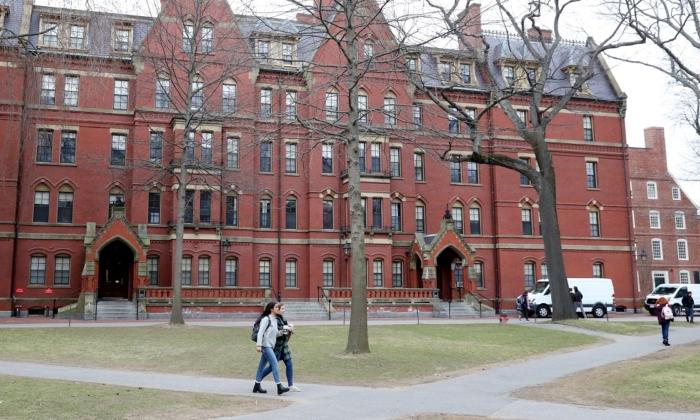The future of racial quotas in university admissions will depend largely on the outcome of one of the most hotly disputed and closely watched cases of the Supreme Court’s new term.
On Oct. 31, the court is scheduled to hear oral arguments in the long-running case of Students for Fair Admissions (SFFA) v. President and Fellows of Harvard College, which will address the use of race-based admissions policies not only at Harvard but at the University of North Carolina (UNC) at Chapel Hill.
The lawsuit, which seeks to overturn the 2003 ruling in Grutter v. Bollinger permitting universities to consider race in admissions decisions with the aim of augmenting diversity, began as two separate legal actions against the two institutions. Their contention was that such discriminatory policies unfairly disadvantage Asian American applicants (and, in the case of UNC, white applicants), violating Title 6 of the Civil Rights Act of 1964.
Harvard’s Woes
The case has drawn national attention and, in the case of Harvard, proved to be a major headache when it emerged that the university missed the deadline for filing a claim with its excess insurance provider, Zurich American Insurance, for coverage of legal costs. As a consequence of its sloppiness, the university risks being unable to recoup an additional $15 million in legal fees, after the school exhausted its $25 million claim limit with its primary insurer.Edward Blum, founder of SFFA, described the universities’ stances as “adversarial.”
Such a stance is played out not only in the courtroom, but also by university leadership who “play an adversarial role in defending what they do and arguing for racial classifications and preferences in admissions,” Blum told The Epoch Times.
The school’s singling out of Blum by name may have overstepped certain bounds, he acknowledged.
“One could say it wasn’t necessary for Harvard to identify me by name on their website. I’m the president of the organization that is the named plaintiff. But every lawsuit needs a villain, and every lawsuit needs a hero,” he said.
Contrary to Harvard’s assertion that the lawsuit grew out of “preconceived conclusions,” Blum described a long and meticulous process of meeting with officials and gathering and analyzing data to reach a basis on which to assess the fairness and legality of the university’s policies.
“We presented our evidence after years and years of discovery, where we interviewed officials at Harvard and UNC and were given documents showing that Harvard and UNC basically had a quota system that will limit the number of Asians at Harvard and the number of Asians and whites at UNC,” Blum said.
Strong Data
The lawsuit targeting Harvard relies heavily on econometric data compiled by Duke University economics professor Peter Arcidiacono, who argued in a 168-page report (pdf) that Harvard’s policies were most favorable to African American applicants, followed by Hispanics, and then by whites, and that Asian applicants were the worst off.Arcidiacono described the case of a hypothetical Asian male applicant whose scholastic achievements and qualifications afforded him a 25 percent chance of admission. That same applicant would have a 36 percent chance of admission if he were white, a 77 percent chance if Hispanic, and a 95 percent chance if black, the professor determined.
“Race plays a significant role in admissions decisions,” Arcidiacono wrote.
Blum’s methodology also rests on evidence and figures uncovered in the course of his lengthy discovery indicating that, in 1993, approximately 19 percent of incoming freshmen at Harvard were Asian, and in 2014, the year he initiated his legal action against the school, the percentage was the same. This seemed off given that the number of people of Asian descent applying to Harvard has grown markedly during and since the period in question.
“This is only one small element of the data that we presented to the courts to prove that Harvard is trying to racially ‘balance’ every ethnic group within its freshman class,” Blum said.
Outcome Not Certain
In Blum’s view, the evidence may be clear, but the Supreme Court could still go either way in its decision.“There are a number of possible outcomes,“ he said. ”One would be that the court rejects our arguments and says Harvard and the University of North Carolina aren’t violating the current legal boundaries, and [racial quotas are] permitted, and we lose. The next possibility would be that the schools are found to be in violation of these boundaries, and they’re told, ‘Shame on you. Now go back and fix what you’re doing.’”
If the lawsuit has its intended result, it will not only strike down racial quotas at Harvard and UNC, but set a precedent that will ultimately spell the end of race-based admissions policies at colleges and universities throughout the country, Blum added.
But he acknowledged that, in the event of an unfavorable ruling for the universities, either school may pursue appeals or look for ways to cheat.
“This may be the end of the beginning, rather than the beginning of the end,” Blum said.
Harvard and UNC didn’t respond to requests for comment by press time.





